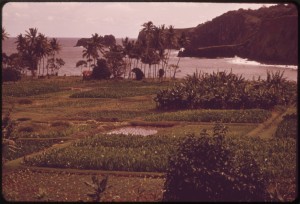
By: Mark Sheehan “The ancient Vedas say, ‘In this handful of soil rests the future of humanity.’ If we care for it we have a future and if we destroy it we destroy our own existence.” – Dr. Vandana Shiva
Think back to 10 or 15 years ago. Did you imagine tons of ice melting every second? Or than yearly superstorms would be wreaking havoc on our coasts? Did you envision fracking earthquakes and the Gulf of Mexico as a dead zone? How about the Pacific gyre of trash? Cities where people can’t breathe? Could you foresee Maui County as ground zero for GMO crop testing? Or that we’d pass the SHAKA bill? Did you think we’d get to the Paris climate change agreement?
Now think ahead about 15 years. It’s 2031. Are things better? Will our beaches be in the same place? Will there even be beaches? Will airport runways be moved inland? Will Kahului harbor still function? Will 90 percent of our food still be imported? Or might we be generating most of our own power and growing our own food?
Change comes as a shock to the system, like Alexander and Baldwin (A&B) pulling the plug on sugar. Though the collapse has been expected for years, the final notice startled many and unleashed a wave of media nostalgia for ‘good old plantation days.’
And after years of loyal hard work, we expect the company to invest in the future of their employees’ training. Likewise, we understand the relief expressed by families who have suffered asthma and had to rush kids to the ER instead of to school.
As part of the Big Five that ruled Hawaii with an iron fist, A&B controlled the legislature as easily as they controlled water delivery to their plantations. Their western/industrial system was used to convert the indigenous managed lands into plantation monoculture. Then they dumped untold tons of chemicals on fields from Kauai to Maui.
Will the plantation owner shift practices? Can we trust them to restore life to the soil, to convert to real agriculture that will support our families 50 years from now? I think they will need input from all stakeholders who desire truly sustainable, regenerative agriculture.
Such plans are in the works and will soon be made public. In David Montgomery’s classic, Dirt: The Erosion of Civilizations, he writes: “Given that the state of the soil determines what can be grown and for how long, preserving the basis for the wealth of future generations requires intergenerational land stewardship.” Good management requires husbanding this ‘natural capital.’ He continues, “Cultivating a field year after year without effective soil conservation is like running a factory at full tilt without investing in either maintenance or repairs.”
Dr. Shiva insists that real soil is full of life; that respecting the soil and giving back to the soil is the single, most important action we can take.
Hawaiians have a saying: “To plan for the future look to the past.” Looking before the plantation era to the early Hawaiian practices, we see a system based on long-term land, stream and ocean stewardship.
With this in mind, Maui’s local farmers- ranchers, Upcountry growers, organic farmers, taro growers – need to share their wise practices with A&B and HC&S management to help them devise a long-term plan for the vast central Maui plain that should be our breadbasket. We can start by cleaning up contaminants, stopping erosion, and building a living food web based on local, non-toxic inputs.
Future food security requires we rethink our whole system – from where we get our energy and food, to how we allocate public trust waters for the health of our islands rather than the wealth of corporations. If A&B has a viable plan, we’d have seen it by now.
It’s time for all stakeholders to speak up now with their best ideas. Let’s plan for long-term health, not short-term wealth.
The four indigenous speakers at the recent Food Justice Summit reminded us that people are rising up all over the world to challenge corporate control of food. “No maiz, no pais.” No corn, no country.
A revolutionary force of connected awareness is changing the world from Panang to Paia. Let’s all join in!
